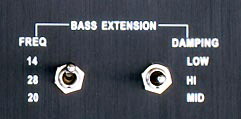You have no items in your shopping cart.
* Free UPS ground shipping to any continental US address
* Discounts when purchasing dual subs
* Discounts when sub is purchased with our speakers
$1,910.00
High Output 15" Servo Subwoofer!
FV15HP is our answer to the need for a high power home theater solution that retains the dynamic and accurate bass that we have become known for.
Properly integrated, our vented subwoofers can achieve the tight bass normally associated with a sealed enclosure, yet with greater low frequency output. We recommend this subwoofer for systems in which home theatre has a high priority.
FV15HP SUBWOOFER DESCRIPTION
Direct Servo Technology
All our subwoofers use our patented Direct Servo technology, providing high end performance at an affordable price. It allows us to use lighter and more efficient drivers and still achieve deep bass without using excessive amounts of power. The servo reduces memory effects, counteracts thermal compression and various forms of driver non linearities.
H600PEQ3 Amplifier and DS1510 Driver
FV15HP uses our new high power H600PEQ3 servo amplifier and DS1510 driver. DS1510 features anodized aluminum cone, a 3" voice coil, and 200 oz magnet. Its linear excursion range has increased to +/- 20mm (from +/-15mm of DS1500). The entire subwoofer is 12lbs heavier. It also comes with a grill.
FV15HP is the smallest in size (but highest in output) among the top 3 commercial ported subwoofers tested at data-bass 12.5hz output comparison. The subwoofer can be shipped via UPS regular ground shipping. Even at 16hz comparison, we are the number 6 highest output.
The standard amplifier is H600PEQ3 (600WRMS PEQ). The quickguide of the PEQ3 amplifier for vented subs can be found here . PEQ3 amps do not have high pass filter RCA output. The response curves with various extension frequency/damping combinations of both amplifiers can be found in our EQ page.
FV15HP SUBWOOFER FEATURES
Features & Options
Product features include:
- Patented Direct Servo technology
- 15" silver anodized aluminum high excursion driver
- 600w high power H600PEQ amplifier
- Solid and very inert enclosure
- Bass extension controls allowing adjustment of bass extension and excursion control
- Balanced XLR input option
- Parametric EQ
All our subwoofers feature our Direct Servo technology, which is our secret to achieving tight and accurate bass. The benefits are far more than simply achieving low distortion.
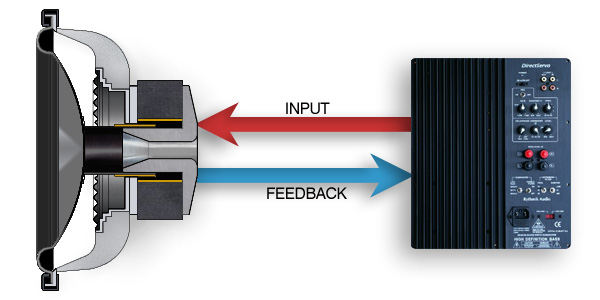
Learn more in our technology articles ![]()
15" black anodized aluminum high excursion driver
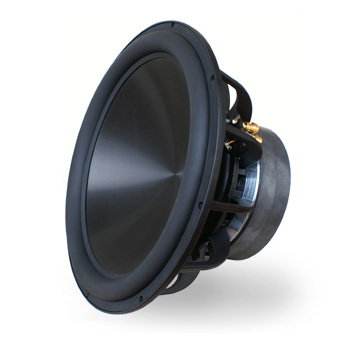
DS1510 Driver features include:
- 3" voice coil for high thermal power handling and low thermal compression
- Rigid black anodized aluminum cone ensuring control at high SPL
- Low moving mass to ensure an exceptional transient response
- High flux density in the gap to ensure low distortion
- Flux modulation shorting rings to lower inductance and improve linearity
Compared to our standard range of drivers, our DS1510 has a 3" voice coil which has a high thermal power handling and features lower power compression. While designed primarily for their sound quality, these custom designed drivers are also stylish in appearance with a anodized aluminum cone and rubber surround. Unfortunately, it's not possible to judge the accuracy of a driver by observing its appearance. There are other drivers on the market which in fact look quite similar, and it's tempting to think that they are comparable. Many of them are inferior in performance due to a heavy moving mass, the absence of shorting rings, wider gaps around the voice coil and high inductance which limits the useable high frequency cut off point. Many aren't suitable for a crossover point higher than 50 Hz. This is very limiting when one considers the large number of home theatre speakers which perform better when relieved of bass duties.
Our enclosures are very solid and well braced to minimize any cabinet resonances or coloration. The baffle into which the driver is mounted is double thickness.
We also provide a range of finishes.
All of our subwoofers feature unique bass extension controls which are not normally provided on subwoofers. This enables the user to customize the output and extension to achieve the best compromise in any room. Most subwoofers neglect to provide bass extension control, and the result is that dynamic headroom is compromised.
To suit different setups, we provide a 12 db and 24 db/octave crossover. If you are using an AVR, then we recommend "AVR/12" (or EXT/12 in older amps). If you are still using stereo receiver or conventional pre/power amp setup, then we recommend the 80hz/24 db/octave setting. To understand more about how to correctly integrate your subwoofer, read our phase alignment article.
Further details on the various controls and settings included are available on our amplifier page ![]()
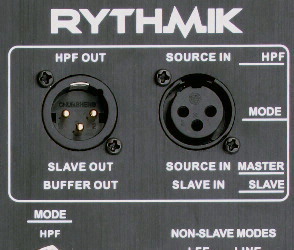 |
For professional use, a balanced input version is available. The outputs allow multiple subwoofers to be connected. Simply daisy chain the connections, running output from the first (master) subwoofer to the input of the next. For home use, balanced connections are not normally required. However, for those using studio processors and EQ units with balanced outputs, this option may be more convenient. If connection to a source with RCA connectors as found on my home audio equipment, an adaptor may be used. In this case it should be noted that the connection can no longer be considered balanced. |
Shown above is XLR2 option. Slave subwoofer units each have their own phase and PEQ adjustment, allowing for placement apart from each other. All other controls will use the same settings as the master sub. Therefore you can adjust the gain on the first and it will control the gain on all the others. The servo will still function normally, correcting any non linearities in each individual subwoofer. We also have XLR3 options with two XLR inputs and no XLR output.
For more information, including charts showing response with different settings, view our amplifier page ![]()
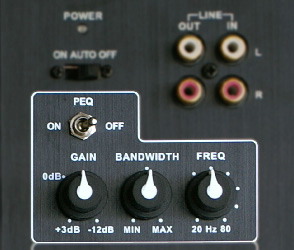 |
Our PEQ version comes with a few extra options which aren't provided on our standard amplifier. First, there is one band of parametric EQ with adjustable frequency, gain and bandwidth. This means you can not only control the boost or cut, but also the width of the filter. Additional bass management options are also provided. A switch allows the user to select a 12 or 24 db/octave crossover slope setup option. Where the higher slope (24db/octave) is selected, the amplifier uses a variable 12db/octave filter in addition to a fixed 12db/octave filter. One can choose with a switch the corner frequency of the fixed filter as either 50 or 80 Hz, which will suit most situations. The variable filter can be used for fine tuning. |
FV15HP SUBWOOFER SPECIFICATIONS
The bass extension controls allow the user to customize the deep bass extension and the rumble filter to control cone excursion. For high SPL, one can set a higher cut off. For music one may prefer a lower cut off. Changing the settings can also result in a better integration with the acoustic gain of the room.
| Specifications | |
| Driver | DS1510 15" high excursion with custom sensing coil |
| Driver materials | Black anodized aluminum with rubber surround |
| Cast aluminum basket | |
| Copper flux de-modulation shorting rings | |
| Amplifier | 600 RMS class H patented servo controlled |
| Dimensions | 18-1/4"(W) x 24-1/2" (H )x 24-1/4"(D) - (26-1/2" D with grille and control knobs) |
| Shipping Weight | 130 lbs (gross weight 115lbs) |
| Frequency Response | 12 - 200 Hz (-2 dB @ 17 Hz, -6db@12hz) with LFE input |
| 12 - 90 Hz ((-2 dB @ 17 Hz, -6db@12hz) with LINE IN input | |
| Multi-tune | 18hz (2 port) and 12hz (1 port) |
| Crossover slope | Selectable 12 or 24 dB / octave (PEQ) |
| Crossover range (Low pass) | 25 - 100 Hz |
| Rumble Filter (High pass ) | 18 Hz 18 dB / octave for two port tuning |
| Phase adjustment | 0 - 180 degrees continuously variable |
| Bass damping factor settings | high (Q=0.5), med (Q=0.7), and low (Q=1.1) |
| Finishes | Available in black matte vinyl or black oak vinyl |
| Warranty | 5 years warranty on driver and 3years on electronics |
| 45 day satisfaction guarantee |
FV15HP SUBWOOFER MEASUREMENTS
FV15HP has two port openings. With two ports open, the max extension is 18hz and the rumble filter should be set to ON/2 position. In the following is the frequency response when extension filter is set to 14hz and low damping.
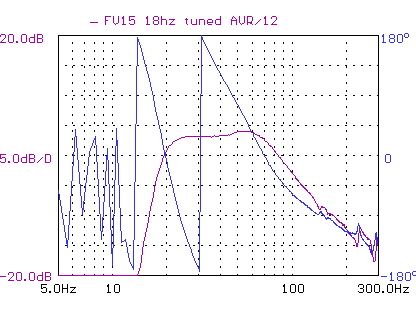
Fig 1.0 - FV15HP Frequency response chart in AVR/12 low pass filter setting and both ports open
To achieve lower group delay and lower bass extension at 12hz, customer can plug one of the ports and set the rumble filter position to OFF/1. In the following is the resulting frequency response with extension filter set to 14hz and low damping.
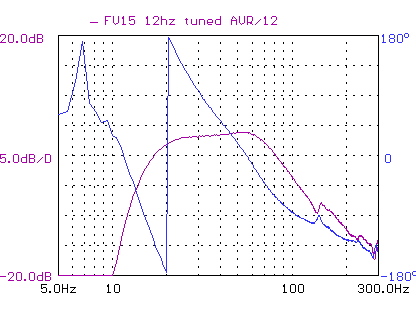
Fig 1.1 - FV15HP Frequency response chart in AVR/12 low pass filter setting and one port open
The level matching between two port mode and one port mode is very good as shown in the following figure when the volume setting is unchanged and the rumble filter setting is at ON/2 and OFF/1, respectively.
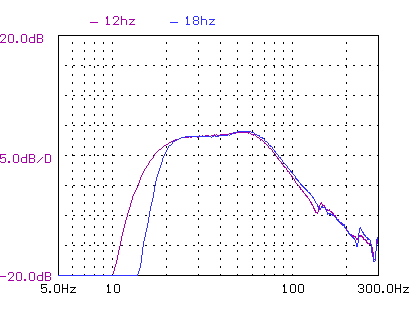
Fig 1.2 - FV15HP level matching level two port and one port modes when the rumble filter is set ON/2 and OFF/1, respectively
FV15HP also provides an LFE mode that extends the upper end to 200hz as shown below.
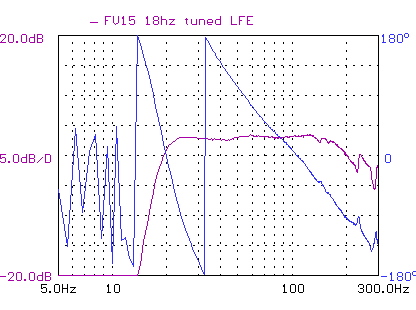
Fig 1.3 - FV15HP LFE mode response with two port
Integration
One important aspect of getting a correct integration is phase alignment. We have written a guide on how to achieve a phase aligned subwoofer. More ![]()
FV15HP SUBWOOFER SUMMARY
These are some of the finest subwoofers ever manufactured and the difference in sound quality between these subwoofers and the typical big-box ported subwoofer is surprising. You will hear the difference the very first time you listen and as so many have said, you will never go back to a non-servo subwoofer.




























